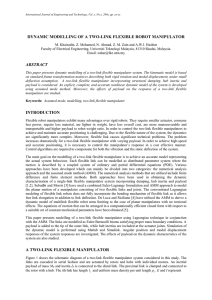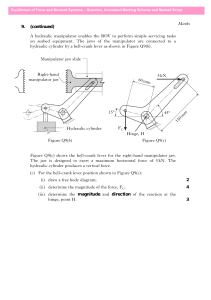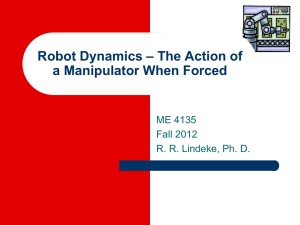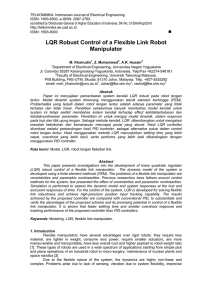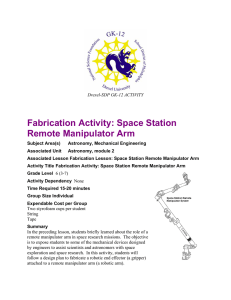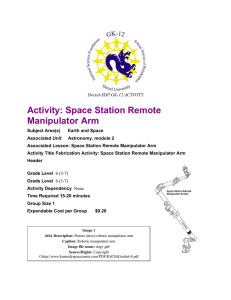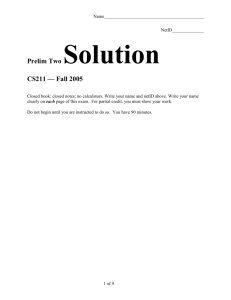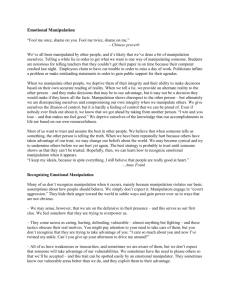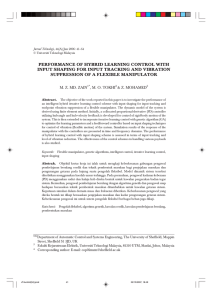The Second International Conference on Control, Instrumentation and Mechatronic Engineering... Malacca, Malaysia, June 2-3, 2009
advertisement
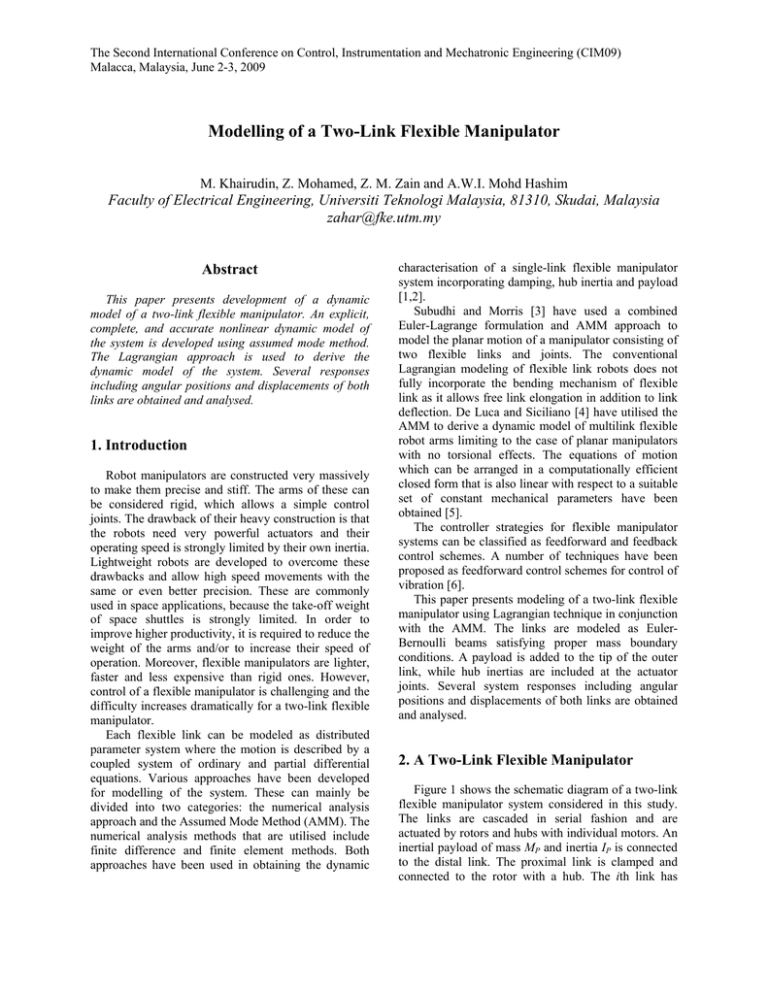
The Second International Conference on Control, Instrumentation and Mechatronic Engineering (CIM09)
Malacca, Malaysia, June 2-3, 2009
Modelling of a Two-Link Flexible Manipulator
M. Khairudin, Z. Mohamed, Z. M. Zain and A.W.I. Mohd Hashim
Faculty of Electrical Engineering, Universiti Teknologi Malaysia, 81310, Skudai, Malaysia
zahar@fke.utm.my
Abstract
This paper presents development of a dynamic
model of a two-link flexible manipulator. An explicit,
complete, and accurate nonlinear dynamic model of
the system is developed using assumed mode method.
The Lagrangian approach is used to derive the
dynamic model of the system. Several responses
including angular positions and displacements of both
links are obtained and analysed.
1. Introduction
Robot manipulators are constructed very massively
to make them precise and stiff. The arms of these can
be considered rigid, which allows a simple control
joints. The drawback of their heavy construction is that
the robots need very powerful actuators and their
operating speed is strongly limited by their own inertia.
Lightweight robots are developed to overcome these
drawbacks and allow high speed movements with the
same or even better precision. These are commonly
used in space applications, because the take-off weight
of space shuttles is strongly limited. In order to
improve higher productivity, it is required to reduce the
weight of the arms and/or to increase their speed of
operation. Moreover, flexible manipulators are lighter,
faster and less expensive than rigid ones. However,
control of a flexible manipulator is challenging and the
difficulty increases dramatically for a two-link flexible
manipulator.
Each flexible link can be modeled as distributed
parameter system where the motion is described by a
coupled system of ordinary and partial differential
equations. Various approaches have been developed
for modelling of the system. These can mainly be
divided into two categories: the numerical analysis
approach and the Assumed Mode Method (AMM). The
numerical analysis methods that are utilised include
finite difference and finite element methods. Both
approaches have been used in obtaining the dynamic
characterisation of a single-link flexible manipulator
system incorporating damping, hub inertia and payload
[1,2].
Subudhi and Morris [3] have used a combined
Euler-Lagrange formulation and AMM approach to
model the planar motion of a manipulator consisting of
two flexible links and joints. The conventional
Lagrangian modeling of flexible link robots does not
fully incorporate the bending mechanism of flexible
link as it allows free link elongation in addition to link
deflection. De Luca and Siciliano [4] have utilised the
AMM to derive a dynamic model of multilink flexible
robot arms limiting to the case of planar manipulators
with no torsional effects. The equations of motion
which can be arranged in a computationally efficient
closed form that is also linear with respect to a suitable
set of constant mechanical parameters have been
obtained [5].
The controller strategies for flexible manipulator
systems can be classified as feedforward and feedback
control schemes. A number of techniques have been
proposed as feedforward control schemes for control of
vibration [6].
This paper presents modeling of a two-link flexible
manipulator using Lagrangian technique in conjunction
with the AMM. The links are modeled as EulerBernoulli beams satisfying proper mass boundary
conditions. A payload is added to the tip of the outer
link, while hub inertias are included at the actuator
joints. Several system responses including angular
positions and displacements of both links are obtained
and analysed.
2. A Two-Link Flexible Manipulator
Figure 1 shows the schematic diagram of a two-link
flexible manipulator system considered in this study.
The links are cascaded in serial fashion and are
actuated by rotors and hubs with individual motors. An
inertial payload of mass MP and inertia IP is connected
to the distal link. The proximal link is clamped and
connected to the rotor with a hub. The ith link has
The Second International Conference on Control, Instrumentation and Mechatronic Engineering (CIM09)
Malacca, Malaysia, June 2-3, 2009
length l i and uniform mass density per unit length ρi .
E and I represent Young modulus and area moment of
inertia of both links respectively. A payload is attached
at the end-point of link-2.
manipulator system needs to be computed using the
kinematics formulations explained previously. The
total kinetic energy of the manipulator (T) can be
written as
Y0
T = TR + TL + TPL
Yi
where TR, TL and TPL are the kinetic energies associated
with the rotors, links and the hubs, respectively. As
shown in Figure 1 and the kinematics formulation
described previously, the kinetic energy associated
with the payload can be written as
Payload
ොi
ܻ
(3)
Y2
Link-2
X2
Θ2
Link-1
ෝi
ܺ
& =
where Ω
n
Xi
θ1
1
1
& + υ& ′ (l )) 2
M p p& nT+1 p& n +1 + I P (Ω
n
n n
2
2
TPL =
X0
Figure 1. Structure of a two-link flexible manipulator
The first link is clamped on the rotor of the first motor.
The second motor is attached to the tip of the first link.
X 0 and Y0 are the inertial coordinate frame. θ1 and
θ 2 are the angular position and vi ( xi , t ) are the
transverse component of the displacement vector. M p
∑
n
j =1
θj +
∑
n −1
υ& ′ (l )
k =1 k k
(4)
; n being the link
number, prime and dot represent the first derivatives
with respect to spatial variable x and time, respectively.
The potential energy of the system due to the
deformation of the link i by neglecting the effects of
the gravity can be written as
n
U =
1
2
∑ ∫
i
li
0
2
⎛ d 2υ i ( xi ) ⎞
⎟ dx
( EI ) i ⎜
⎜ dx 2 ⎟ i
i
⎠
⎝
(5)
The effectiveness masses at the end of the individual
links can be obtained as
is an inertial payload mass with inertia J p at the endpoint of second link.
M L1 = m2 + mh 2 + M p
J L1 = J o 2+ J h 2 + J p + M p l22
3. Modelling
The description of kinematics is developed for a chain
of n serially connected flexible links, revolute joints
and motion of the manipulator on a two-dimensional
plane, the rigid transformation matrix, Ai , from Xi-1Yi-1
to Xi Yi is written as
⎡cos θi
Ai = ⎢
⎣ sin θi
− sin θ i ⎤
cos θi ⎥⎦
(1)
The global transformation matrix Ti transforming coordinates from X0Y0 to Xi Yi follow a recursion as
Ti = Ti−1Ei −1 Ai
(2)
To derive the dynamic equations of motion of the
system, the total energy associated with the
(6)
MD1 = 0 , M L 2 = M p J L 2 = J p MD2 = 0
,
,
The co-ordinate vector consists of link positions, (θ1,
θ2) and modal displacements (q11, q12, q21, q22). The
input vector, F = {τ1, τ2, 0, 0, 0, 0}T, where τ1 and τ2 are
the torques applied by rotor-1 and rotor-2, respectively.
Therefore, the Euler–Lagrange’s equations, with i = 1
and 2 and j = 1 and 2 can be obtained as:
∂ ⎛ ∂L
⎜
∂t ⎜⎝ ∂θ&i
⎞ ∂L
⎟−
⎟ ∂θ = τ i
i
⎠
(7)
The Second International Conference on Control, Instrumentation and Mechatronic Engineering (CIM09)
Malacca, Malaysia, June 2-3, 2009
∂ ⎛⎜ ∂L
∂t ⎜⎝ ∂q& ij
⎞ ∂L
⎟−
=0
⎟ ∂qij
⎠
(8)
allowing the manipulator to, initially, accelerate and
then decelerate and eventually stop at target location.
Finally, a set of dynamic equations can be written in
compact form as
0.25
0.2
0.15
⎧⎪θ&&⎫ ⎧ f (θ ,θ&) ⎫ ⎧ g1 (θ ,θ&, q, q&) ⎫
M (θ , q)⎨ ⎬ + ⎨ 1
⎬+⎨
⎬
⎪⎩q&&⎭ ⎩ f 2 (θ ,θ&)⎭ ⎩g 2 (θ ,θ&, q, q& )⎭
⎧ 0 ⎫ ⎧ 0 ⎫ ⎧τ ⎫
+⎨ ⎬+ ⎨ ⎬ = ⎨ ⎬
⎩Dq& ⎭ ⎩Kq⎭ ⎩0⎭
(9)
Torque (Nm )
0.1
0.05
0
-0.05
-0.1
-0.15
where f1 and f2 are the vectors containing terms due
to coriolis and centrifugal forces, M is the mass matrix,
and g1 and g2 are the vectors containing terms due to
the interactions of the link angles and their rates with
the modal displacements. K is the diagonal stiffness
-0.2
-0.25
0
Table 1 shows the physical parameter of the twolink flexible manipulator used in this simulation. M Li ,
EI and G represent the mass of link, flexural rigidity
and gear ratio respectively. J hi is the inertia of the
motor and hub and M h 2 is the mass of centre rotor at
the second motor.
Table 1. Parameters of The System
Symbol
Parameter
Value
Unit
ML1=ML2
ρ
G
EI
Jh
Mp
l
Ip
Mh2
Mass of link
Mass density
Gear ratio
Flexural rigidity
Motor and hub inertia
Payload mass
Length
Payload inertia
Mass of the centre rotor
0.1
0.2
1
1.0
0.02
0.5
0.5
0.0025
1
kg
kgm-1
Nm2
kgm2
kg
m
kgm2
kg
A two-link flexible manipulator was excited with
symmetric bang-bang torque inputs with amplitude of
0.2 Nm and 1 s width as shown in Figure. 2. For
validation of the dynamic models, simulations were
conducted on the manipulators with the same input
trajectories. A bang-bang torque has a positive
(acceleration) and negative (deceleration) period
3
4
5
Figure 2. The Bang–bang Input Torque
Figure 3 shows the response of the angular
positions of link-1 and link-2 of the system with
payload of 0.5 kg. It is noted that the angular positions
for Link-1 of 16.5 degrees and Link-2 is -34 degrees,
respectively, were achieved within 2 s.
30
link1
link2
20
10
A ngular pos itions (degree)
4. Simulation Results
2
Time (s)
matrix which takes on the values ωij 2 mi and D is the
passive structural damping.
1
0
-10
-20
-30
-40
-50
-60
0
500
1000
1500 2000 2500 3000 3500
Time (ms)
4000 4500
5000
Figure 3. Angular Position of Link-1 and Link-2
Figures 4 and 5 show modal displacements of link1 and link-2 of the system with a payload of 0.5 kg.
For link-1, it is noted that the maximum displacements
are 8.8×10-3 m and 5.5×10-3 m for mode 1 and mode 2
respectively. For link-2, the maximum displacements
are 0.08 m and 2.5×10-3 m.
The Second International Conference on Control, Instrumentation and Mechatronic Engineering (CIM09)
Malacca, Malaysia, June 2-3, 2009
.
0.01
mode1
mode2
0.008
M odal displacem ent of Link-1 (m )
0.006
2
Link-1
Link-2
1.5
E nd-point ac c eleration (m /s ec 2 )
Figure 6 shows response of the end-point
acceleration of link-1 and link-2. The maximum endpoint accelerations for link-1 and link-2 of the system
were found to be 0.23 m/sec2 and 1.30 m/sec2
respectively.
1
0.5
0
-0.5
-1
0.004
0.002
-1.5
0
-2
0
500
1000
-0.002
1500 2000 2500 3000 3500
Time (ms)
4000 4500
5000
Figure 6. Response of end-point acceleration.
-0.004
-0.006
-0.008
-0.01
0
500
1000
1500
2000 2500 3000
Time (ms)
3500
4000 4500
5000
Figure 4. Modal Displacement of Link-1.
Figure 7 shows frequency response of end-point
acceleration of link-1 and link-2. In this work, power
spectral density (PSD) of the response is analysed. For
payload 0.5 kg, the resonance frequencies for the first
two modes of vibration respectively were obtained as 1
Hz and 7 Hz.
-5
10
0.1
mode1
mode2
10
M agnitude ((m /sec/sec)*(m /sec/sec)/Hz)
0.08
0.06
M odal dis plac em ent of Link -2 (m )
Link-1
Link-2
-6
0.04
0.02
0
-0.02
-0.04
-0.06
-7
10
-8
10
-9
10
-10
10
-11
10
-0.08
-12
10
-0.1
0
500
1000
1500 2000 2500 3000 3500
Time (ms)
4000 4500
Figure 5. Modal Displacement of Link-2.
0
10
5000
20
30
40
Frequency (Hz)
50
60
70
Figure 7. PSD of end-point acceleration response.
5. Conclusion
The development of dynamic model of a two-link
flexible manipulator incorporating payload has been
presented. The model has been derived using EularLagrange and AMM. Simulation exercises have been
The Second International Conference on Control, Instrumentation and Mechatronic Engineering (CIM09)
Malacca, Malaysia, June 2-3, 2009
conducted to study and verify the performance of the
system. Several responses including angular positions
and displacements of both links are obtained and
analysed.
Acknowledgement
The authors gratefully acknowledge Universiti
Teknologi Malaysia (UTM) and the Ministry of
Science, Technology and Innovation (MOSTI) for the
research funding under ScienceFund No. 03-01-06SF0026.
References
[1] Tokhi MO, Mohamed Z, Azad AKM, “Finite difference
and finite element approaches to dynamic modelling of
a flexible manipulator,” Proceeding of IMechE-I:
Journal of Systems and Control Engineering, 1997;
211:145-156.
[2] Tokhi MO, Mohamed Z, Shaheed MH, “Dynamic
characterization of a flexible manipulator system,”
Robotica, 2001;19:571-580.
[3] Subudhi B, Morris AS., “Dynamic Modelling,
Simulation and Control of a manipulator with flexible
links and joints,” Robotics and Autonomous System,
2002; 41:257-270.
[4] De Luca, B. Siciliano, “Closed-form dynamic model of
planar
multi-link
lightweight
robots,”
IEEE
Transactions on Systems, Man, and Cybernetics 21 (4)
.1991. 826-839.
[5] S. Morris, A. Madani, “Inclusion of Shear Deformation
Term to Improve Accuracy in Flexible-Link Robot
Modelling”, Mechatronics, Vol. 6, No. 6. 1996, pp. 631647.
[6] Z. Mohammed, J.M. Martins, M.O. Tokhi, J. Sa’da
Costa, M.A. Botto, “Vibration control of very flexible
manipulator system,” Control Engineering Practise 13
(2005), 267-277.
